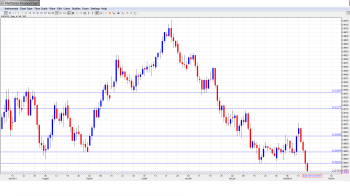AUD/USD lost ground throughout the week, losing about 150 points. The pair closed the week below the 0.88 line. This week’s key release is Employment Change. Here is an outlook on the major market-movers and an updated technical analysis for AUD/USD.
Australian Employment Change was a disaster, adding fuel to the Aussie’s slide this week. In the US, the recovery continues to gain strength. Unemployment Claims remained at low levels, and Core Retail Sales and the Philly Fed Manufacturing easily beat their estimates.
[do action=”autoupdate” tag=”AUDUSDUpdate”/]
AUD/USD graph with support and resistance lines on it. Click to enlarge:
- MI inflation Gauge: Sunday, 23:30. The indicator provides analysts with monthly consumer inflation data, as official CPI is released on a quarterly basis. The indicator has been very steady, and posted a reading of 0.2% last month. No major change is expected in the upcoming release.
- Chinese GDP: Monday, 2:00. Key Chinese events can affect the direction of AUD/USD, since China is Australia’s number one trading partner. GDP is released each quarter. The G3 reading improved to 7.8%, up from 7.5% in G2. This matched the estimate. The estimate for G4 stands at 7.6%.
- Westpac Consumer Sentiment: Tuesday, 23:30. This indicator is an important gauge of consumer confidence, which is closely linked to consumer spending. The indicator has fluctuated and posted a sharp decline of 4.8% in November. The markets will be hoping for a turnaround in the December release.
- CPI: Wednesday, 00:30. One of the most important economic indicators, CPI is released each quarter, magnifying the impact of each reading. In G3, CPI jumped 1.2%, beating the estimate of 0.8%. The markets are expecting a lower gain for Q4, with the estimate standing at 0.5%.
- Trimmed Mean CPI: Wednesday, 00:30..Trimmed Mean CPI excludes the most volatile 30% of items which make up CPI. The index posted a gain of 0.7% last month, matching the estimate. The markets are not expecting much change in the December release.
- MI Inflation Expectations: Thursday, 00:00. This indicator has been fairly steady in recent readings. The indicator gained 2.1% last month, a four-month high. The markets will be hoping for another gain close to the 2.0% mark.
- Chinese Flash Manufacturing PMI: Thursday, 1:45. This key index has indicated expansion in the Chinese manufacturing sector in recent readings, but just barely, with recent readings just above the 50-point level. More of the same is expected in the upcoming reading, with an estimate of 50.6 points.
*All times are GMT.
AUD/USD Technical Analysis
AUD/USD started the week at 0.9022 and quickly touched a high of 0.9086. It was all downhill from there ,as the pair slipped below the 0.88 line, touching a low of 0.8763, as support at 0.8728 (discussed last week) held firm. The pair closed the week at 0.8769.
Technical lines from top to bottom:
With the Aussie sliding last week, we start at lower levels:
0.9283 saw a lot of action in the months of June and July, alternating between resistance and support roles. It has provided steady resistance since November.
0.9180 is the next line of resistance. It is followed by the round number of 0.9000, which continues to see activity. It has reverted to resistance line as we start the new week.
0.8893 was busy as the Aussie lost ground and crashed through this support level. It is currently providing strong resistance.
0.8728 was last breached in July 2010, when the Australian dollar began an extended rally that saw it climb close to the 1.10 line. It held firm as the AUD/USD dropped to the mid-0.87 range late last week.
This is followed by 0.8578, which has remained intact since July 2010, which saw the pair put strong pressure on the 0.83 line.
Next is 0.8432 played a key support role in late 2009.
The final support line for now is 0.8365, which was an important resistance line in July 2009.
I am bearish on AUD/USD.
The slumping Aussie fell below the 0.88 level for the first time in over three years. With QE a reality in the US and another taper expected in the near future, the Aussie could lose more ground. The currency continues to be weighed down by the RBA, which has made no secret that it wants the Australian dollar trading at lower levels.
- For a broad view of all the week’s major events worldwide, read the USD outlook.
- For EUR/USD, check out the Euro to Dollar forecast.
- For the Japanese yen, read the USD/JPY forecast.
- For GBP/USD (cable), look into the British Pound forecast.
- For the Australian dollar (Aussie), check out the AUD to USD forecast.
- USD/CAD (loonie), check out the Canadian dollar.

